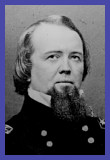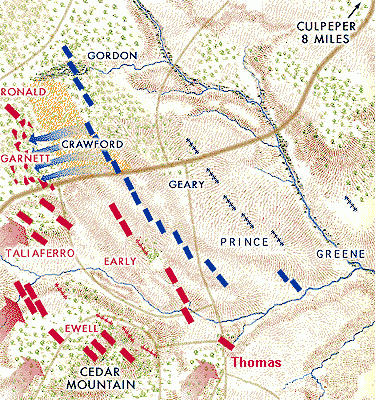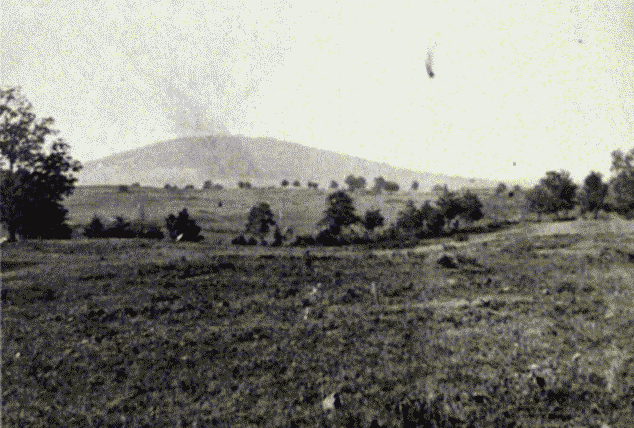For
the next week, the Confederate Army waited for the Union Army to attack.
When Lee realized McClellan had moved most of his forces out of Virginia,
Hill's division was marched to the south of Richmond, where they went into
quarters. Hill's new division had met every challenge thrown at them, and
Hill himself had performed admirably. But now after suffering nearly 5500
casualties, the division rested and licked its many wounds.
During this period, the 3rd Louisiana troop commander, Edmund Pendleton was
promoted to Colonel and given his own brigade, and the 3rd Louisiana regiment
soldiers were augmented into other Louisiana regiments. Thomas' brigade was
now all Georgian, but Thomas himself gained more responsibilities. Joseph
Anderson, at the request of the Confederate Congress, resigned his military
office and returned to run the Tredegar Iron Works. While soldiers and officers
were important to the Southern cause, the munitions factory at Richmond would
become a major supplier of arms to the South. Thomas, while still in command
of the 35th regiment was now put in command of the entire brigade.

John
Pope
courtesy
General
Officers of the Civil War
Early
in the summer of 62, division commander AP Hill got into a severe conflict
with his superior officer, James Longstreet, that nearly culminated in a
duel. Hampered by a shortage of officers, Lee stepped in and put a halt to
the duel, and in an attempt to rectify the problem, transferred Hill's Light
Division from Longstreet's Corps to Stonewall Jackson's Corps on July 27th.
Jackson, who was warily watching the Union Army under new commander Major
General John Pope moving out of Washington, accepted the brash new commander
and his needed troops. The 35th Georgia now became part of what was known
as "Jackson's foot cavalry". They didn't have long to wait to find out where
the nickname came from.
With forces on the tip of Virginia still threatening Richmond, Lee felt it
was time to take the war back north and put the front lines back near Washington
DC. Pope was marching his army south, and Lee gave Jackson orders to delay
them. The aggressive Jackson was sent northwesterly to block the Union advance,
while Longstreet was to follow with the intention of turning this defensive
move into hopefully, an offensive one. The same day they were transferred
to Jackson's command, the Hill division began loading onto trains and shuffling
from Richmond to Gordonsville, Virginia. Here, the rest of Jackson's Corps
was encamped. On August 6th, Jackson put his Corps on the march. Having received
word that the advancing Union Army was spread out dangerously thin, Jackson
decided to attack the leading divisions of Nathaniel Banks Union Corps and
defeat them before they could retreat or be reinforced. For two full days
the Confederate Corps marched, Hill's Division in the rear. The morning of
the ninth looked to be another full day of hot, dusty marching, but early
in the afternoon, sounds of battle raged north of Hill's Division. The men
continued forward as Jackson hurriedly threw the leading elements of his
Corps into battle formation. It would be nearly 5:30 before Thomas' brigade,
leading the Hill division, would arrive at the battlefield. To their right
sat Cedar Mountain, sometimes called Slaughter's Mountain (nicknamed after
Revolutionary soldier, Capt Philip Slaughter). To their left sat heavy woods.
But to the front, on open ground, Jackson's forces were in severe trouble.
Part of Thomas' brigade of Georgian's, including the 35th, 45th, and 49th
Georgia regiment's, were immediately sent to the right flank of the Confederate
line, where General Early's forces were being hard pressed. Rushing at the
double quick into line, the Georgian's would take position's behind a fence
line and as Early would later write "their arrival was very timely". Attacking
Early' men were Union division's under General Henry Price. These included
the 3rd Maryland, 102nd New York, 109th and 111th Pennsylvanian's, and element's
of the 8th and 12th US Battalion's. The lead division's of the 3rd Maryland
and 111th Pennsylvanian's were followed by the 109th Pennsylvania and 102nd
New York. In a miscue, the Union rear element's mistakenely fired a volley
into the 3rd Maryland, and the two front element's of this Union advance
had fallen back. Trying to keep order, General Price would be captured. Now,
the 109th advanced toward the hard pressed right flank of General Early,
while the 102nd New York wheeled to their left to face the newly arrived
Georgian's under Thomas. Thomas' men fired a volley, and as Early would later
write, "effectively checked (the Federal) progress, strewing the ground
with the killed."

In the mean time, the 14th Georgia, which had been in the rear of the Thomas'
brigade, played a key part in stopping the complete rout of the Confederate
left line. Followed closely by the rest of Hill's Division, Folsom's Georgian's
advanced through fleeing Confederate troops and effectively stopped the Union
advance. Reinforced by other element's of Hill's Division, Archer and Pender's
troops would crush the advance and make a successful charge of their own,
thus ending the battle.
The
day ended for the 35th Georgia with a loss of 9 men killed and 17 wounded.
The timely arrival of Hill's division was the determining factor in the outcome
of the battle, with the Georgian's arriving on the right flank in time to
help Early turn back a strong assault, and the following brigades rushing
in to secure the already crumbling left flank.

View
of Cedar Mountain from Union position
Photo compliments of
US
Army Military History Institute Carlisle
Barracks
More reading on Cedar Mountain
35th
Georgia Index
|


